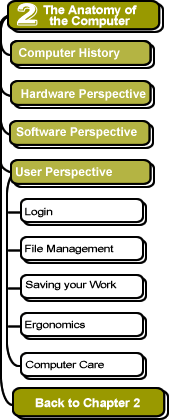

|
Ergonomics - Preventing
Backaches and Headaches
Even if you only use a computer for a short period of time, you should learn a few simple rules to prevent physical problems associated with computer use.
-
 You
should position the computer keyboard so that your forearms are parallel
to the floor while you type (with your elbows at approximately a 90
degree angle).
You
should position the computer keyboard so that your forearms are parallel
to the floor while you type (with your elbows at approximately a 90
degree angle). - Your feet should be flat on the floor with your upper legs parallel to the floor.
- The computer display monitor should be at a height and angle so that you look down at a slight angle. Use a keyboard and mouse wrist pad.
- Good posture is important to prevent problems such as backaches or carpal tunnel syndrome.
- Look up once in a while from your work, and take breaks once in a while to stretch and move around.
- Be sure to blink! Research has shown that computer users' eyes often become irritated because most people blink less often when working on a computer. Your computer monitor displays images on the screen in a way similar to a television. At least 60 times a second, the entire display is refreshed, with the computer lighting each tiny spot of the screen with the right color, starting from the top row and working down to the bottom, lighting each row from left to right. The human eye cannot detect such rapid activity, so the screen appears stable. However, some people can consciously or subconsciously see a bit of flicker with a refresh rate of 60 times a second (60 Hertz, or 60 Hz for short). If you get headaches from too much computer work, you may be able to adjust the refresh rate to 75 Hz or even higher, but be sure to follow the manufacturer's instructions, since monitors are designed to operate only at certain rates. (If you get headaches from too much of any kind of work, a higher refresh rate might not help.)
![]()
![]()
These pages were written by Steven H. VanderLeest and Jeffrey Nyhoff and edited by Nancy Zylstra
©2005 Calvin University (formerly Calvin College), All Rights Reserved
If you encounter technical errors, contact computing@calvin.edu.